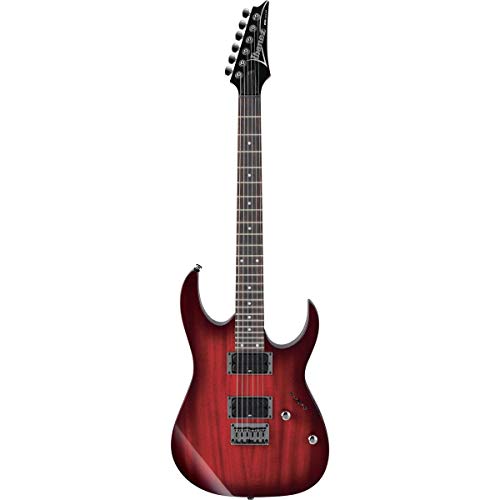The main factors that will influence the comfort of a neck are the shape and the width of the fretboard. Since the neck has very little impact on the overall tone of the guitar, you can focus entirely on how the neck feels in your hands and not worry about what changes it’s making to your sound. We’ve picked out some of the guitar necks rated highest for player comfort and reviewed them below.
These are our recommendations for the 4 most comfortable guitar necks on the market:
Fender American Stratocaster Guitar Neck
The Fender Stratocaster (see the entire guitar here) is one of the most popular models in the history of the electric guitar. A lot of that popularity is because they’re so easy and fun to play. The design of the neck has a lot to do with this player comfort. The Strat has used a few different neck designs over the years, and of these the modern version, like this Fender American Stratocaster neck, is considered to be the most comfortable for the most players.
This neck has 21 medium-jumbo frets set into a channel-bound rosewood fingerboard. This makes the feel of it incredibly smooth, with no side seams to speak of. The overall design uses a modern C-shape for maximum finger comfort, regardless how big your hands are. It also uses a compound radius, meaning it gets flatter as you go higher, making it easier to employ bends and similar techniques.
The only downside to this neck is its cost. The Fender Player Stratocaster linked to above can cost about as much as the stand-alone neck, so if you’re in the market for an entirely new guitar you might as well go for it.
Flameer Unfinished Mahogany Guitar Neck for Gibson LP
The Les Paul is another iconic guitar model, beloved by players from all levels and styles. Most players love the feel of the neck but get frustrated by how heavy most Les Paul models are. Getting this Flameer Mahogany Les Paul-style neck can give you that playing comfort on a lighter-weight guitar.
It’s made of durable mahogany with a 22-fret rosewood fretboard, exactly the materials you’d expect from a Gibson-made Les Paul neck. The bolt-on design makes it easy to install, too. It’s a drop-in replacement for any Gibson or Epiphone Les Paul, though it’s certainly not limited to those applications.
While this neck excels in the comfort department, it’s not as aesthetically pleasing as some other options. The unfinished headstock and basic mother of pearl inlays probably won’t turn any heads. This isn’t surprising given the bargain price, of course. If you’re shopping for substance (and value) over style, this Flameer neck is one of the most comfortable guitar necks for the money period.
Fender Telecaster Neck
If you have larger hands, a U-style neck is likely to be the most comfortable style for you to play. The Thinline Fender Telecaster (see the guitar itself here) neck found on modern professional models of the instrument will give you this profile. Combined with the vintage-style frets, this neck is an ideal mix of classic design and modern comfort.
This is one of the more flexible aftermarket necks in terms of installation. It has the 3-bolt mounting design seen on Telecasters from the ‘70s, but it can also be attached to modern guitar bodies—and not just Fenders, either. The nut is also pre-slotted to make re-stringing the guitar easy.
The smooth finish on the fretboard feels great under your fingers when you play this Fender neck. Old-school players will also love the 7.25” neck radius, the same measurement you’ll find on classic Teles. The only negative we found is that the truss rod is at the butt end, which makes adjusting the neck relief a bit of a hassle. The good news is you won’t have to adjust this often. All-told, this is a well-made and easy to play neck at a good value.
Ibanez RG421Ibanez Wizard III (Wizard III 3pc Maple Neck)
Any list about comfortable necks would feel incomplete without mentioning the Wizard III from Ibanez. This innovative design gives you one of the slimmest profiles around. Combined with jumbo frets and the D-shaped neck contour, this is the ideal neck for high-tempo genres and screaming solo licks, built for both comfort and speed.
The fret design is impressive on this neck, too. Ibanez was the brand that popularized the jumbo fret. The scalloped frets facilitate fast slides, while the compound radius of the fingerboard gives it a nice low action, again making it more playable, especially at high speeds.
Ibanez guitars are especially well-loved in the hard rock and metal genres, and the Wizard necks are a big reason why. There’s no off-brand equivalent or after-market fix that can give you the speed of a Wizard III. The good news is Ibanez instruments are very affordable. You can get a whole new guitar for less than you’d pay for high-end Fender replacement necks, and the investment is well worth it.
Most Comfortable Guitar Neck Shapes and Profiles
The basic shape of a guitar neck is described using the letter it most resembles in profile. Many vintage guitars use a V-shaped neck, but this isn’t the most comfortable option for most players. Modern luthiers tend to gravitate toward flatter, smoother shapes, like the modern-C found on many newer Strats or the D-shape used on the Wizard III.
While most players will find a flattened profile more comfortable, players with larger hands might want something a bit chunkier. The U-shaped neck found on many Telecasters is an excellent choice if you have longer fingers and often feel cramped playing on other neck styles.
Remember, the impact of the neck on your tone is negligible, so you can make your choice based solely on how it feels. Best of luck finding the most comfortable guitar neck for your needs!







